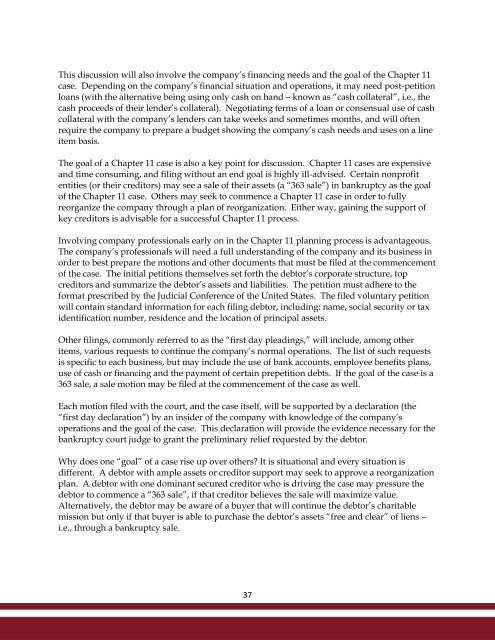Guide-for-Nonprofit-Organizations-Bankruptcy-Issues-FINAL-with-ads
Guide-for-Nonprofit-Organizations-Bankruptcy-Issues-FINAL-with-ads
Guide-for-Nonprofit-Organizations-Bankruptcy-Issues-FINAL-with-ads
- No tags were found...
Create successful ePaper yourself
Turn your PDF publications into a flip-book with our unique Google optimized e-Paper software.
This discussion will also involve the company’s financing needs and the goal of the Chapter 11case. Depending on the company’s financial situation and operations, it may need post-petitionloans (<strong>with</strong> the alternative being using only cash on hand – known as ―cash collateral‖, i.e., thecash proceeds of their lender’s collateral). Negotiating terms of a loan or consensual use of cashcollateral <strong>with</strong> the company’s lenders can take weeks and sometimes months, and will oftenrequire the company to prepare a budget showing the company’s cash needs and uses on a lineitem basis.The goal of a Chapter 11 case is also a key point <strong>for</strong> discussion. Chapter 11 cases are expensiveand time consuming, and filing <strong>with</strong>out an end goal is highly ill-advised. Certain nonprofitentities (or their creditors) may see a sale of their assets (a ―363 sale‖) in bankruptcy as the goalof the Chapter 11 case. Others may seek to commence a Chapter 11 case in order to fullyreorganize the company through a plan of reorganization. Either way, gaining the support ofkey creditors is advisable <strong>for</strong> a successful Chapter 11 process.Involving company professionals early on in the Chapter 11 planning process is advantageous.The company’s professionals will need a full understanding of the company and its business inorder to best prepare the motions and other documents that must be filed at the commencementof the case. The initial petitions themselves set <strong>for</strong>th the debtor’s corporate structure, topcreditors and summarize the debtor’s assets and liabilities. The petition must adhere to the<strong>for</strong>mat prescribed by the Judicial Conference of the United States. The filed voluntary petitionwill contain standard in<strong>for</strong>mation <strong>for</strong> each filing debtor, including: name, social security or taxidentification number, residence and the location of principal assets.Other filings, commonly referred to as the ―first day pleadings,‖ will include, among otheritems, various requests to continue the company’s normal operations. The list of such requestsis specific to each business, but may include the use of bank accounts, employee benefits plans,use of cash or financing and the payment of certain prepetition debts. If the goal of the case is a363 sale, a sale motion may be filed at the commencement of the case as well.Each motion filed <strong>with</strong> the court, and the case itself, will be supported by a declaration (the―first day declaration‖) by an insider of the company <strong>with</strong> knowledge of the company’soperations and the goal of the case. This declaration will provide the evidence necessary <strong>for</strong> thebankruptcy court judge to grant the preliminary relief requested by the debtor.Why does one ―goal‖ of a case rise up over others? It is situational and every situation isdifferent. A debtor <strong>with</strong> ample assets or creditor support may seek to approve a reorganizationplan. A debtor <strong>with</strong> one dominant secured creditor who is driving the case may pressure thedebtor to commence a ―363 sale‖, if that creditor believes the sale will maximize value.Alternatively, the debtor may be aware of a buyer that will continue the debtor’s charitablemission but only if that buyer is able to purchase the debtor’s assets ―free and clear‖ of liens –i.e., through a bankruptcy sale.37


